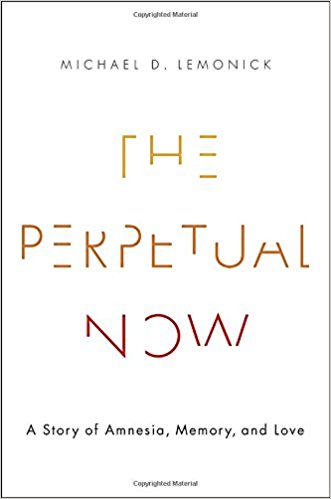 The Perpetual Now: A Story of Amnesia, Memory and Love by Michael D. Lemonick, published by Doubleday, 2016. Visit the author’s website at http://michaeldlemonick.com/ for ordering info and an audio clip from the book.
The Perpetual Now: A Story of Amnesia, Memory and Love by Michael D. Lemonick, published by Doubleday, 2016. Visit the author’s website at http://michaeldlemonick.com/ for ordering info and an audio clip from the book.
Wow, folks. I actually read a physical book. This is another product of time spent at the library while our house was being shown. I cannot tell you how fascinating it is. You must, must, MUST read it. It is so engagingly written, about such an engaging subject, that you’ll find it . . . engaging.
The book would be worth reading even without the drama of the main’s character’s loss of memory, as it centers around a remarkable family, the Johnsons. The parents of Lonni Sue Johnson, the central figure, were a world-class physicist and an equally-world-class artist. They had one of the world’s best marriages, at least as it’s presented in the book. And Lonni Sue’s sister, Aline, is an immensely-talented computer analyst and musician. As for Lonni Sue herself, she was a commercial artist whose work was published on the cover of The New Yorker magazine five times.
So when Lonni Sue came down with a mysterious illness in the bitter upstate-New York winter of 2007, she was someone with a richness of experience and therefore memory. Not only did she have her artistic talent but she was also a private pilot, musician and dairy farmer. (That last wasn’t going all that well.) She had a warm, open personality and scads of friends. People just “fell in love with her,” we’re told several times. She was in her late fifties and had moved from New York City to live in the country when she came down with encephalitis. The infection attacked her brain and basically “burned out” her hippocampus, the part that gives us our memory. When she recovered from the illness she had forgotten almost everything in her previous life and, even more crippling, had lost the ability to form new memories. So, although she could recognize her mother and sister (the father had already died), she couldn’t do that with other people, even those she’d been friends with for many years. She had to be told over and over that her father had died. She could no longer support herself, no longer be allowed to go out by herself, no longer function independently. She will live the rest of her life in an assisted-living facility.
But there’s more to the story than that, and I’m not even going to try to summarize it. If you’re interested in how our brains work and the mystery of human personality, you’ll find this book fascinating. Lonni Sue hasn’t really lost her “self.” She’s just lost her memory. And her willingness to let neuroscientists run exhaustive and exhausting tests on her in order to tease out unresolved mysteries about how the brain works is a testament to her generosity. Her question about each new round of experiments is always, “Will this help other people?” She has moved forward to make a life within her limitations. As the author sums up, when Lonnie Sue wakes up every morning, “She’ll be mostly unaware of all that she has lost. But most of the time, it doesn’t seem to matter at all.”